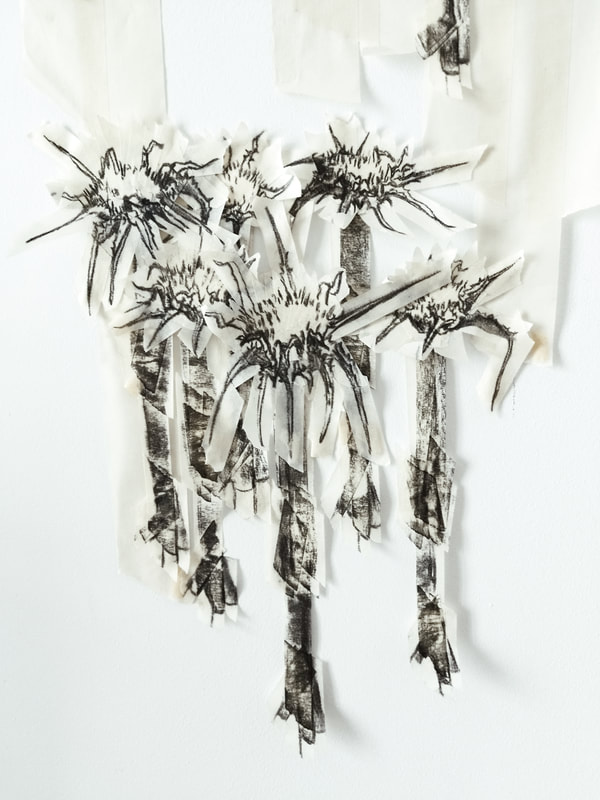The Good Shepherd
Charcoal and gold pigment on masking tape, 2023
|
"The Good Shepherd" charcoal on maskingtape drawing is part of a multi-layered interactive installation consisting also Charms and a soundwork. The installation is rich with references to mythological stories and quotes from Jewish texts. Ritov uses the concept and the symbolic image of "The good shepherd and his sheep" and replaces the male figure with her own portrait.
The figure of the "Good shepherd" deeply rooted in Western culture, in the various ancient mythologies and in the three monotheistic religions, is always represented as a robust, healthy, young man (physically and spiritually) who carries on his shoulders a goat (or other young farm animal) intended as a sacrifice to God. His appearance in myths and the Holy Scriptures symbolizes the connection between man and God, representing the belief in the Fatherly God, who cares and protects his believers from all evil, while fulfilling the commandment to give sacrifices in order to maintain the religious system and the social and spiritual order. From a personal, female, contemporary, as well as maternal point of view, Ritov breaks and shatters the patriarchal paradigms in which the "leader" is the father, the all-knowing shepherd, under whose protection a flock is led without asking any questions. She turns the role of the protector and savior towards herself, consisting of a personal flock of goats (young and old), while demanding the cancellation of the victim-victimizer type of relationships. In the drawing, Ritov's portrait merges twice with the goat figure: once as an adult goat, the protector of the herd, and once as a young goat who long-silenced her fate as a sacrificial object. The shout of marking borders and breaking the silence in agreement, Ritov spreads through talismans: red threads and a written psalm. Reading the psalm over and over again by the audience, is a continuous ripple ofRitov's personal voiceless shout. *In order to receive a talisman, the audience must make a donation that will be given at the end of the exhibition to "Bonot Alternativa" (Building an Alternative) - a non-governmental activist pressure group of women in the Israeli economy and society, who work resolutely for the promotion of social equality, the empowerment of women and the creation of an egalitarian and safe reality for women. According to the Mishnah (the first major written collection of the Jewish oral traditions that are known as the Oral Torah), ten things were created on Shabbat night between the suns (Twilight time between Friday and Saturday): ten corrections to the Torah that would appear later in the Scriptures. One of them is "the mouth of the Aton (donkey)": the Aton opened her mouth and came out against Balaam (Numbers 22) her owner and proved his immorality and the injustice he caused her. This means the potential of the power of speech and its power to build or tear down worlds. "The mouth of the donkey" is miraculous. This is the first time in the Bible that the creations are reversed, the victim defies his owner and thereby promotes a social miracle. The Good Shepherd Psalm
I am the good shepherd, the keeper of borders, flocks and sleep. After thousands of years - I have awakened. It's not too late, I'm here. I am the Good Shepherd, not in the form of Hermes, Jupiter, Isaac, Jesus but rather in my own image, I will keep the goats, young and old, together we will graze in the meadow. Together we will direct our gaze. Stone the trespassers. My sisters, my souls, we will no longer wander as victims, as an offering or atonement, as scapegoats or black sheeps. No more, we will accept in surrender, as a decree of fate from those who come to harm us. In between the suns, the she-ass rebuked Bilaam and opposed him In between the suns I have awakened to graze my flock of goats in thistle fields. |







